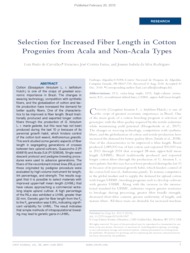Selection for increased fiber length in cotton progenies from Acala and Non-Acala types.
Selection for increased fiber length in cotton progenies from Acala and Non-Acala types.
Summary: Cotton (Gossypium hirsutum L. r. latifolium Hutch.) is one of the crops of greatest economic importance in Brazil. The changes in weaving technology, competition with synthetic fibers, and the globalization of cotton and textile production have increased the demand for better quality fibers. One of the characteristics to be improved is fiber length. Brazil traditionally produced and exported longer cotton fibers through the production of G. hirsutum L. r. marie galante, but this race has not been produced during the last 10 yr because of its perennial growth habit, which hinders control of the cotton boll weevil, Anthonomus grandis. This work studied some genetic aspects of fiber length in segregating generations of crosses between two upland cultivars, Guazuncho 2 (PI 606819) and Acala SJ4 (PI 529538). Single-seed descent protocol and pedigree breeding procedures were used to advance generations. The fibers of the recombinant inbred lines (RILs) and those originated by pedigree procedure were evaluated by high-volume instrument for length, lint percentage, and strength. The results suggest that it is possible to select materials with improved upper-half mean length (UHML) that have values approaching a commercial extralong staple upland cultivar. A high percentage of the RILs also exhibited a UHML greater than 32 mm. Genetic gain for fiber length from the F4 to the F5 generation was 6.8%, indicating significant variability for UHML. The result indicates that simple methods of intrapopulational breeding may lead to genetic gains in UHML.
Publication year: 2015
Types of publication: Journal article
Unit: Embrapa Cotton
Observation
Some of Embrapa's publications are published as ePub files. To read them, use or download one of the following free software options to your computer or mobile device. Android: Google Play Books; IOS: iBooks; Windows and Linux: Calibre.
Access other publications
Access the Agricultural Research Database (BDPA) to consult Embrapa's full library collection and records.
Visit Embrapa Bookstore to purchase books and other publications sold by Embrapa.

